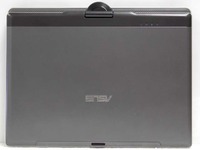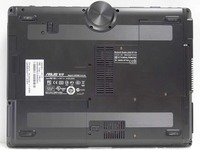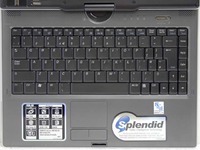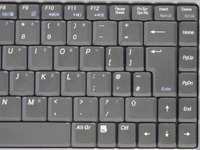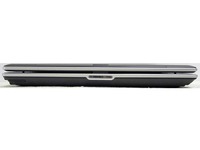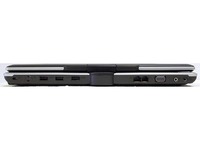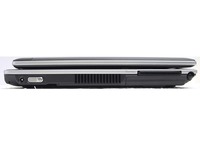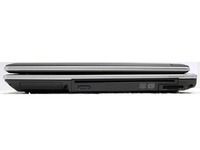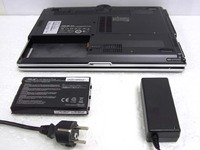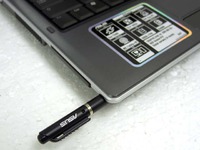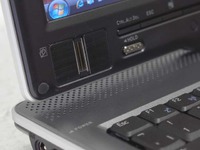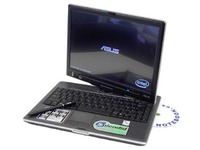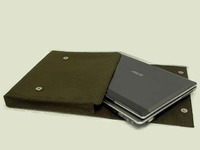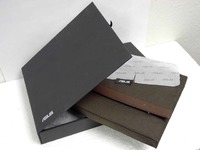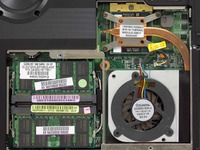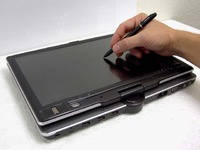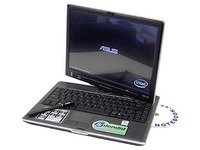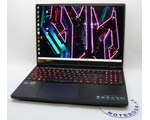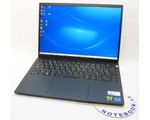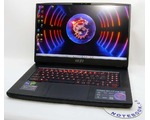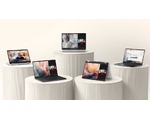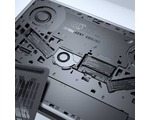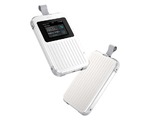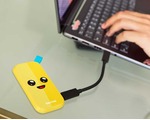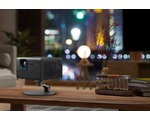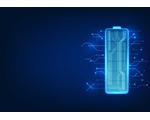ASUS R1F - First Tablet PC from Asus
9. 11. 2006 00:59 Rubrika: Laptop Review
The Asus company has set off to explore the field of tablet PCs for the very first time and yet we can call the first one a success. It can be described best by the 13,3'' widescreen LCD, Core Duo, 2GB DDR2 memory and an attractive finish. It's going to deliver not only all the benefits of its pen-responsive screen, but also performance that exceeds demands of the office work.
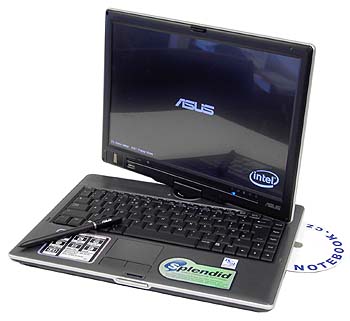
Basic description
Light grey plastic was used to manufacture the body and it was decorated by silver components. The buttons and sliders have a metal look and together all this makes a very nice design. The fabrication is fine, the only negative is that the plastic can be squeezed a little around the monitor.
It feels a little unusual to find almost all the I/Os on the rear side of the appliance. On the left side there is the hot air exhaust, ExpressCard bay, a pen storage slot, a power button and right behind that is the AC connector slot. On the right side there is only a card reader (MS, MS Pro, MMC, SD) and an optical unit in a bay you can also use to plug in another battery. This can be easily removed by using a switch on the bottom of the laptop followed by pulling the unit out. There's only a display panel button on the front side and all the rest of ports is on the back.
To be specific there are 3 USB ports, external monitotr output, TV-out port, modem and Gigabit Ethernet (GLAN) connectors, SPD-IF and MIC and a Kensington lock port on the rear side.
I do not find this layout the most lucky one, at least not if you want to use the laptop not only in the tablet mode. Then all these ports would be hidden behind the display.
The notebook is equiped with the fingerprint reader which is logically situated in the lower left part of the display case so that it can be used in the talblet mode as well. For the very same reason there is also an integrated microphone and some buttons around the LCD.
The indicator LEDs are all blue and clearly visible. The basic group is in the lid, to the right under the display (status, battery, BT, Wi-Fi, HDD), the second one is to the right, above the keyboard (Key locks and an incoming mail) and the third one is on the top side of the lid (status, battery, BT, Wi-Fi).
The lid can be opened after pressing a button on the front. Its hinge is pretty stiff and holds position quite well, but of course the need to rotate the display means that it cannot be as good as with the classical notebook construction. The direction in which the lid should be rotated is advised by white arrows in both (closed/opened) states. When in a tablet mode the lid should be secured by a reversible latch, which is operated by the display panel button.
Keyboard and operating elements
What definitely deserves appreciation is the build of the keyboard, mainly because of its effortless and silent travel of the keys and also because it barely bends during writing on it. The keys are dark grey, the signs light grey and functional combinations, as usual, blue. It all works well, but I would be pleased by a little higher contrast of these colours.
There are Shift, Caps Lock, Backspace and Enter keys of regular size. The last column on the right belongs to Home, Delete, Pg Up etc. The palm rests are sized reasonably, meaning large enough but still decent.
Unfortunately the TouchPad is not of the same ratio as the displey and it's made of a material not really comfortable to slide a finger on which I personally consider a minus. It does not have a directional button but it still has got a scrolling area on the right side of it.
Above the keyboard on the right there is a slider for switching the radios (WiFi, BT) on/off and a button for choosing particular power management profile.
Dimensions of this tablet are 315 x 250 x 35mm (12.4 x 9.84 x 1.28 in.) and its weight is 2,4kg (5.29lbs). Mobility is therefore very fine and even everyday carriage will not be a problem.
Operating a tablet PC
Being a tablet, this PC is suited to be worked on even without the keyboard and all the top side of its body. The power button is situated on the left side and we can find different buttons scattered around the display. Namely it's the Escape key, a key to switch between Landscape (16:10) and Portrait (10:16) modes of orientation of the display, and (this amused me a bit) a key labeled "Ctrl+Alt+Del". Besides the finger print reader there's also a HOLD slider which protects the buttons on the lid from being pushed unintentionally. Unfortunately it does not protect the power button as well.
Working with the pen is without any problems, the display is quite sensitive and of course there is a software that can be used to set details, like how will the pen react after holding it or a doubleclick. The pen intself has got a button in its lower third that works like a right button and on the top of the pen there is a electronic eraser.
Main HW parameters
Under the hood we find a reliable and widely spreaded Centrino Duo platform. That means that the Core Duo processor T2400 (1.83 GHz, 2MB L2 Cache) is nested in the Intel chipset 945GM (the integrated graphics solution GMA 950 on-board) while being completed by the Intel PRO/Wireless 3945ABG (Wi-Fi network module).
Here are the results the processor achieved in the HWiNFO32 program:
Single-Thread mode (only one core loaded)
- Fixed point unit test: 19089
- Floating point unit test: 14304
Multi-Thread mód (both cores loaded)
- Fixed point unit test: 38428
- Floating point unit test: 28757
When processing integers (fixed p.u.) it conquers front places of our redaction chart but in the FPU test it stays beyond AMD on the same frequency as usual.
The same program measured the RAM read rate 2229MB/s. There are two modules 1GB each running on the effective frequency of 667MHz. Due to the Dual Channel architecture and a high operating frequency, this result is relatively high and means a fifth place in our chart (2006-07-25)
The hard drive was made by Hitachi and bears the HTS541010G9SA00 labelling. It has a capacity of 100GB, 8MB cache, its plates rotate at 5400 rot/min and it is connected via SATA-150 interface.
- HWiNFO32 (read rate while reading from the cache): 101,69 MB/s
- HD Tach (the real average read data transfer rate: 31,2 MB/s
- average random access time: 17,6 ms
Therefore we can say that this HDD belongs to the today's average.
The optical unit is DVD Super Multi type, meaning it can handle all the common CD and DVD types. It is a slot-in type and thus does only have a slot instead of classical rack. Maybe it was just a bad coincidence, but one of the DVDs suffered a light scratch after some pulling and pushing in to the notebook. The noise level is discrete and does not exceed the average height, yet it could behave a little less loudly while rocognizing a disk.
The connection with outer world is possible by wires (GLAN, modem) or wirelessly (Wi-Fi, Bluetooth). Unfortunately that's all because we cannot find neither infraport nor Firewire here. But these are rather less used and easily substituted interfaces.
You can find all the parameters at the end of the article in the table.
Measured performances and graphs are available in the performance tests.
Display and graphics
In my opinion the choice of the 13,3'' pen-responsive screen LCD was a lucky one, because we are quite used to see only 12'' tablets. The R1F's display has a resolution of 1280x800 pixels (WXGA) and it's a glare type. The graphics is handled by Intel GMA 950, which can use up to 128MB of the system memory. This is a logical choice concerning the intended use of such laptop where there is not much need for 3D power.
The viewing angles are relatively nice, only from the side where the joint is, the display has a very weak angle. Fortunately the GMA 950 and the Win XP can handle the desktop rotation very well and so you can set it according to your liking. As I have mentioned above there is a button for an easy switching of the rotation, unfortunately it only can switch from the normal position to 90° clockwise rotation and back. Other orientations have to be set either via a shortcut or two mouseclicks.
It's comfortable that the computer remembers the settings for each position of the computer (laptop/tablet), including the power management settings.
Of course we cannot expect much of a 3D performance from fhe GMA950. 3D Marks are as follows:
- 3DMark 2001: 5495
- 3DMark 03: 1166
- 3DMark 05: 448
- 3DMark 06: 115
You can definitely forget about playing the newest 3D games in other than lowest quality settings and still it will probably be choppy. But have you ever tried to play some Point & Click adventure game on a tablet PC? I can only recommend you that, it's awesome. I have played the Still Life and it was simply another dimension of gaming for me.
Measured performances and graphs are available in the performance tests.
Multimedia
Tablet PCs are destined mostly to business work hence do not expect any multimedia orgies. As in every Asus notebook these days, there is the Splendid video technology but that is in fact all of the enternainment-aimed functions here. The speakers can be relatively loud, but on the other hand with its volume raises the sound distortion. As for the bass sound, you have to, sort of, search them in the sound when playing on a medium volume. If loouder, the bass are still quite an issue, because they seem to sound a bit hollow and they rattle. But again I have to repeat, that this machine is not ment to substitiute a home cinema.
More than playing the owner's favourite DVD, the notebook will probably attend meetings and conferences, where its biggest positives come to play. The intagrated microphone might as well improve effectiveness of the owner's work time. The recording quality and range of the microphone are not better than average.
Security and data protection
The laptop is definitely aimed into the business sphere where confidential data often appears and this of course brings high demands for the data security. No wonder then that we can find the TPM (Trusted Platform Module) chip here, as well as a fingerprint reader. The reader can protect the system boot and/or Windows password. Generally we can say, that the matter of security was considered very important here and therefore the scale of options is huge. Some of the key issues can be set in the BIOS and the rest and more detailed settings are offered in the SW from Infineon, the producer of this particular TPM chip.
Besides the implied function of the administrator password, BIOS also offers to lock down the HDD and let this settings freeze so that the password cannot be changed afterwards. It is also possible to protect the computer against a possible loss of data by disabling all the interfaces including Secondary Master and that is not very common to see.
The capabilities of the SW mentioned above are really impressive. It can encode emails, files and folders, import and manage security certificates, provide data protection during the migration or backing up data and many others concerning e.g. networking or file management system. Together with the BIOS settings the R1F can protect itself from outside attacks as well as to make you sure that your possible employee will not try any tricks. When all the interfaces are secured and the TPM software appropriately set, the only way to get data out is by photographing the screen.
Cooling and noise
The exhaust is situated on the left side of the notebook and the air is inhaled from below it. During normal office work the cooler is a quiet companion, it will of course spin faster when needed, but still it's an agreable noise level.
an hour of use – light load (please read the note below)
- touchpad = 37,1°C (34,2°C)
- left palmrest = 36,3°C (33,7°C)
- right palmrest = 34,8°C (32,3°C)
- right side of the keyboard = 38,6°C (36,3°C)
- left side of the keyboard = 40,3°C (37,8°C)
- maximum on the bottom = 42,5°C in the right side of the bottom side
- exhaust = 48,3°C
-- Note: I have to point out, that this tests was done in the tablet position with the lid on the keyboard. The air circulation was therefore obstructed and thermal offlet limited, but these conditions IMHO are more likely to occur in the everyday use of a tablet. While working with the lid lifted the temperatures were 2°-3°C lower and they are given in the brackets.
an hour of use – extensive load (gaming mostly)
- touchpad = 36,1°C
- left palmrest = 35,3°C
- right palmrest = 33,3°C
- right side of the keyboard = 38,1°C
- left side of the keyboard = 40,8 °C
- maximum on the bottom = 46,8°C in the right side of the bottom side
- exhaust = 51,6°C
temperature of the surroundings: 29,5°C
The temperature is acceptable. It is logically higher with the lid closed, but still it is not alarming. It is interesting that during the office work in the tablet position of the display, the temperature was slightly higher than when gaming with the lid open. That for sure is one of advantages of the integrated graphic solution.
Due to the ventilation holes situated near the center of the bottom side, the laptop can be easily operated on the lap so that legs do not block the air from coming in.
Battery
The battery manufacturer is the Asustek company itself, it has got six cells, capacity of 5200mAh and it provides tension of 11,1V. It isn't really a piece of cake to extract the battery (at least not fot the first time), but after some struggle and use of a decent jemmy (screwdriver or so) it sure will be a success.
It kept the notebook alive for 3 hours and 31 minutes. That is not a brilliant value but rather an average one. We could even call it a bellow-average when talking about light and small notebooks.
BIOS
It can be reached by pressing F2 during the boot sequence and it does not offer any revolutionary options besides those mentioned in the section about security. Nevertheless there still is one small thing. When you press Esc before the boot sequence, you can easily choose between the sources you can boot from. This removes the need to enter the BIOS and set their order temporarily.
Accesories
By default, we find the AC adapter and user's manual, plus in this case a TV-Out to RCA cables reduction and a set to replace the pen's tip. I was slightly surprised by a thorough, almost luxurious wrapping in which I packed the laptop out of the box. From the cardboard box I pulled a nice black box that contained the notebook yet in a textile case with magnetic studs and a leather(ette) edging.
Conclusion
Tablets are a special kind of notebooks, that find their place almost entirely in the business sphere. That's where the R1F most probably goes as well and he will definitelly not be considered an outsider there. Right the opposite: it has got an inch larger display than most of the tablets nowadays and today it is the only tablet featuring Core 2 Duo processors (came after this review was originaly written).
Pros and Cons
+ perfect security
+ design
+ cooling
- missing Firewire and IrDa
*The battery test is performed by a short HDD entry every 30 secs. During the whole time of the test the display is turned on and set to an easily legible level of brightness. Such a workload is near to simulating continual work with documents (letters, tabs etc.). The test is terminated when the battery reaches 3% of its capacity and the computer is turned off. The same procedure is applied on all the notebooks tested by the NOTEBOOK.CZ redactors.
Technická data
- Configuration tested: Asus R1F
- Processor installed: Intel Core Duo T2400 (1.83 GHz, 2 MB L2, 667MHz FSB)
- RAM (MB): 2048 DDR2-667 (2x 1024)
- HDD (GB): 100 (HTS541010G9SA00, SATA 150, 5400 rpm, 8 MB cache)
- DVD: Super Multi DL (MATSHITADVD-RAM UJ-846S)
- LCD: 13,3" TFT with digitizer
- LCD resolution: WXGA (1280 x 800)
- Graphics: Intel GMA 950, 128MB (shared)
- Modem: 56k
- Communications: LAN 10/100/1000, Wi-Fi a/b/g
- Audio: Intel 82801GB ICH7 - High Definition Audio
- Pointing device: touchpad, pen
- Software: Windows XP Tablet PC Edition
- Battery/Stamina: Li-Ion 5200 mAh / 3h 31min
- I/O ports: 1x audio SPDIF, 1x MIC (Line IN), 1x Bluetooth, 3xUSB, 1x Express Card, 1x Wi-Fi, 1x Modem, 1x 4-in-1 (MMC,SD,MS,MS PRO), 1x VGA, 1x TV-Out, 1x GLAN
- Dimensions: 315 x 250 x 35 mm
- Weight (kg): 2.4

